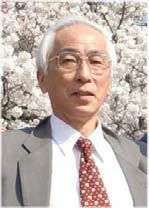Sonderseminar: Prof. Shigemasa Suga - Photoelectron Momentum Microscopy and Soft X-ray Resonant Inelastic Scattering with spatial resolution down to sub-μm scale and prospect of their operand measurements
Osaka Universität
High resolution spin- and angle-resolved photoelectron spectroscopy (SP-ARPES) in micro-nano regions is very widely demanded in order to clarify surface and bulk electronic structures of solids by tuning the excitation photon energies (hν). Spatial resolution is also beneficial for development of spintronics devices. However, extremely low spin detection efficiency has hindered its progress over decades until very recently.
The development of a momentum microscope (M.M.) composed of a PEEM type input lens and an aberration corrected tandem S-type double hemispherical deflection analyzers (DHDAs) has opened a breakthrough. 2 dimentional (2D) momentum dependent EB(kx,ky) can be measured in a very wide k space with high energy and momentum resolutions better than 12 meV and 0.005 Å-1. Nearly 10,000 (kx,ky) points can be simultaneously measured over a full surface/ bulk Brillouin zone (BZ) at the same time for a certain EK(or EB).
2D imaging spin filter such as Au/Ir(001) can be installed behind this M.M. Then spin asymmetric 2D EB(kx,ky) images can be recorded at two electron incidence energies (10.25 & 11.5 eV) with opposite sign of spin sensitivity. From these two spectra, spin resolved spectrum in the wide k space is easily derived in the form of Ps(EB(kx,ky)). Ps(EB(kx,ky,kz) detection is very easy by changing hν. Since the PEEM can collect whole 2π steradian emitted photoelectrons, 2D multi-channel figure of merit of this spin detection is more than ∼million times or sometimes sub-billion times higher than the Mott detector and spin-LEED detector and even ∼10,000 times higher than the most advanced Fe-O VLEED spin detector.
Examples of SP-ARPES measurements of surface Rashba states as well as Dirac cone states of topological insulators by 2D spin filter will be presented. Photoelectron spectroscopy is only useful to conductive materials. In the case of insulating materials, the charging up effects spoils the ARPES, though the details knowledge of their electronic structures are as well demanded quite often. In such a case, photon-in and photon-out experiment as RIXS is ideal, although the micronano study requires the focusing of the excitation synchrotron radiation. The advantage of RIXS is the possibility to be measured under any external perturbations. I will show an example of a study of half metal Heusler alloy under an external magnetic field.
AbstractÜber Prof. Shigemasa Suga
Institute of Scientific and Industrial Research, Osaka University
Dr. Shigemasa Suga ist ein führender Experte für Photoelektronenspektroskopie in Japan und Professor an der Universität Osaka. Er hat maßgeblich zur Entwicklung hochauflösender, bulksensitiver Photoelektronenspektroskopie beigetragen. Für seine herausragenden wissenschaftlichen Leistungen erhielt er 2008 den Helmholtz-Humboldt-Forschungspreis. Professor Suga hat umfangreiche Forschungsergebnisse veröffentlicht und ist international anerkannt für seine Arbeiten in der Materialphysik.
Zeit & Ort
28.06.2024 | 10:15
Hörsaal A (1.3.14)
Fachbereich Physik
Arnimallee 14
14195 Berlin
Weitere Informationen
Gastgeber: Prof. Dr. Wolfgang Kuch
Schlagwörter
- Forschungszentrum Jülich
- Osaka Universität
- Photoelektronenspektroskopie
- Shigemasa Suga
- Spektroskopie
